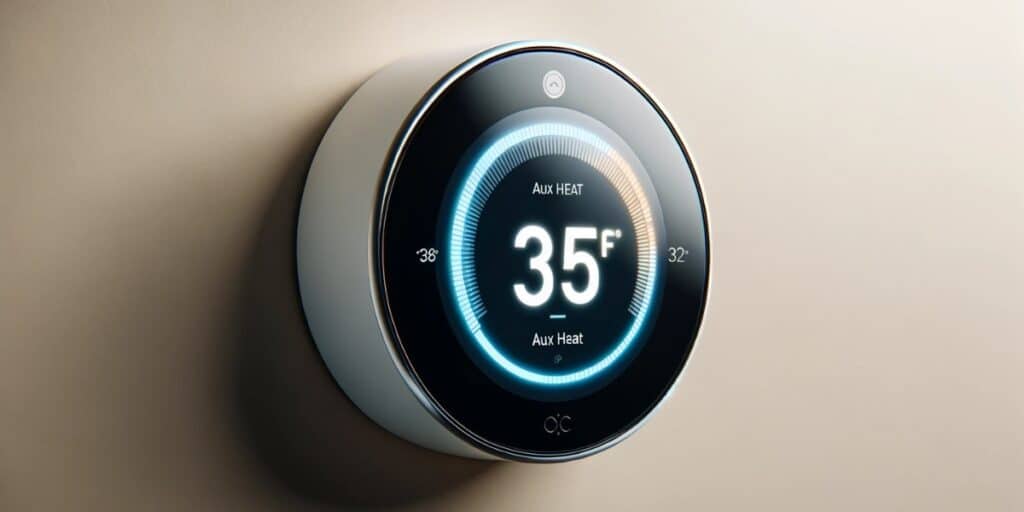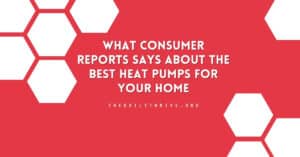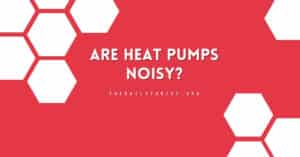When your thermostat displays “auxiliary heat,” it might initially seem problematic. However, this indication indicates that your heating system is working to ensure your comfort. This comprehensive guide will explain what auxiliary heat means, why it activates, and the steps you should take when you see this message on your thermostat.
What is Auxiliary Heat?
Auxiliary heat, often referred to as ‘aux heat,’ is a secondary heating mechanism within your heat pump system. This function automatically activates when external conditions render your primary heat pump less effective at extracting warmth from the outside air. Typically, this switch to auxiliary heating occurs when outdoor temperatures plummet to near or below freezing levels.
An additional scenario where auxiliary heat plays a critical role is during the defrost mode of your heat pump. In such instances, the heat pump shifts to defrost mode to thaw the outdoor condenser. During this process, auxiliary heat prevents cold air from circulating into your home.
How Does Auxiliary Heat Work?
The operation of auxiliary heat responds to specific conditions primarily related to maintaining your desired indoor temperature. When the heat pump alone cannot achieve the set indoor temperature, it activates the auxiliary heat strip. This supplemental heating element assists in warming your home more effectively.
The thermostat is central to regulating when auxiliary heat is triggered. If the indoor temperature drops three degrees or more below the set temperature, the thermostat will activate the auxiliary heat. This ensures a consistent and comfortable indoor environment, even in colder conditions.
Auxiliary heating also comes into play if your heat pump is hindered by ice or snow accumulation. Ice formation can result from issues with the heat strips, which are crucial for defrosting the equipment. Other factors like low refrigerant levels or problems with the outdoor motor fans can also trigger the auxiliary heat.
Your thermostat typically provides an indication when it shifts to auxiliary heating mode. This can be a visual cue, such as a small ‘aux’ light or a digital display reading’ aux heat.’ This alert is useful, helping you understand your heating system’s current operating mode.
Auxiliary heat is an integral part of your heat pump system, designed to provide additional heating support under certain conditions, ensuring your home remains warm and comfortable regardless of the external temperatures or operational challenges the heat pump faces.
Why Does My Thermostat Use Auxiliary Heat?
After understanding what auxiliary heat is and its role in your heating system, it’s important to investigate why your thermostat might activate this secondary heat source. Several conditions under which your thermostat may determine that auxiliary heat is necessary to maintain a comfortable indoor environment. These triggers ensure that your home remains warm, even when the primary heat pump system faces challenges in heating your space effectively.

Let’s explore the various reasons that prompt your thermostat to switch to auxiliary heat.
- Cold Outside Temperatures: Heat pumps extract heat from the outside air. In extremely cold conditions, the air contains less heat for the pump, making it challenging to achieve the desired indoor temperature.
- High Heating Demand: The heat pump alone might not maintain consistent warmth for larger homes or multiple rooms requiring heating.
- Heat Pump Issues: Occasionally, if there are functional problems with the heat pump, it may depend more on auxiliary heat to compensate for its reduced efficiency.
Heat pumps are designed to extract heat from the outside air and transfer it indoors. However, their efficiency is temperature-dependent. As the outdoor temperature drops, the capacity of the heat pump to extract heat diminishes.
To understand this better, consider the concept of the “balance point.” The balance point is a specific outdoor temperature at which the heat pump can no longer extract enough heat to maintain the desired indoor temperature without assistance. For most heat pumps, this balance point typically occurs at around 35°F to 40°F. Below this temperature range, the heat pump starts losing its efficiency rapidly.
When the outdoor temperature falls below this balance point, the heat pump’s ability to absorb heat from the outside air is significantly reduced. This is because the thermal gradient (the difference in temperature between the outside air and the refrigerant within the heat pump) becomes less favorable. In layman’s terms, the colder it gets outside, the less heat is available in the air for the heat pump to “pump” inside.
It’s at this juncture that the thermostat triggers the auxiliary heat. The auxiliary heating system compensates for the heat pump’s diminished capacity by providing additional warmth, ensuring that your home’s temperature remains steady and comfortable, even in the face of plummeting outdoor temperatures. This auxiliary system is typically more energy-intensive and is used only when necessary to maintain indoor comfort.
Is Auxiliary Heat Expensive?
Yes, using auxiliary heat in your HVAC system is more expensive than relying solely on the primary heat pump. This increased cost is primarily due to the operational mechanics of the auxiliary heating system, which often employs electric resistance heating strips, mirroring the technology used in space heaters. While effective in generating heat, these electric strips lack the energy efficiency inherent in heat pump technology.
From a technical and cost-efficiency perspective, consider the temperature-specific operating costs. When the outdoor temperature hovers around 35°F, the operating cost of a standard heat pump is approximately one-third of that of auxiliary heating. This stark difference is because auxiliary heating (electric strips, also known as straight electric heating) requires significantly more energy to produce the same amount of heat.
To contextualize this, auxiliary heat, under these conditions, operates at nearly three times the cost of an efficient heat pump. This substantial increase in operational expense underscores the importance of strategic thermostat settings to mitigate costs.
As a practical suggestion for optimizing energy use and cost, setting your thermostat to about 66°F during nighttime and adjusting it to 69°F during the day can offer a balance. This strategy aims to minimize the reliance on auxiliary heat, leveraging the more cost-effective heat pump system during periods when the temperature differential is less severe, thereby maintaining a comfortable indoor environment in a more energy-efficient manner.
What to Do When “Aux Heat” Appears on Your Thermostat?
While occasional activation of auxiliary heat is normal, particularly during severe cold snaps, persistent use may signal a problem with your heat pump.
Here’s how to stop auxiliary heat from coming on:
- Adjust Your Thermostat: Lowering the thermostat setting slightly can reduce the load on the heat pump, allowing it to catch up without auxiliary heat.
- Inspect Your Air Filter: A dirty or clogged air filter forces the heat pump to work harder, increasing reliance on auxiliary heat. Ensure your filter is clean and replace it if necessary.
- Schedule Regular Maintenance: If the auxiliary heat seems to be operating excessively, it’s advisable to have a professional technician inspect your heat pump. They can diagnose any issues and ensure optimal functionality.
Auxiliary heat on your thermostat is a vital feature that ensures your home stays warm during the coldest days. However, monitoring its usage is important, as excessive reliance on auxiliary heat can lead to higher energy bills. By understanding its function, reasons for activation, and appropriate responses, you can effectively manage your heating system, ensuring comfort and energy efficiency. Regular maintenance and understanding your heating system are key to optimal performance. If you have any further questions or concerns about auxiliary heat or your overall heating system, don’t hesitate to ask for professional advice.






